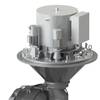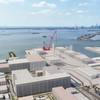Sri Lanka's main port of Colombo hopes to see volumes recover within two years, boosted by development projects, a tariff restructuring and a marketing campaign, the country's ports minister said. "It will be two years before we see a turnaround. We are looking at a faster increase than the natural growth we are seeing now," Ronnie de Mel told Reuters in an interview. "We want transshipment, which is bringing in less than 50 percent of our volumes, to grow through improved efficiency in handling," he said. Transshipment and container handling volumes through the port have fallen during the last two years because it has been unable to handle large container vessels and a bloated workforce and a lack of technology have led to inefficiency. High tariffs have also driven out large shipping lines, prompting them to form alliances with competing regional ports. Total container traffic at Colombo port in the period from January to November was 1.6 million TEUs, up just 2.02 percent over the same period in 1999. Total volumes fell 2.4 percent in 1999. But transshipment volumes were down 2.1 percent in the first 11 months of 2000 after dipping 3.2 percent over the previous full year.
De Mel said an ongoing project by local conglomerate John Keells Holdings Ltd. and Britain's Peninsular and Oriental to expand one of Colombo's terminals had already improved handling speeds and drawn positive response from shipping lines. The government was also spending $50 million on a four-year project to develop the port's main Jaye terminal and has commissioned a feasibility study for a $20 million project to increase its access channel width and depth.
Another feasibility study for a $1.2 billion project to double Colombo's capacity in 10 years has also been completed. "The major development projects will lift the present quays up to international standards and help expand capacity that will be full in 2004 even at current growth levels," de Mel said. "We will restructure our tariffs once the developments start coming in place," he said.
De Mel said Colombo was forced to charge higher bunkering and handling fees mostly because it had twice the labor necessary. "We now have 19,000 cadres but can do with 8,000-9,000 when more computerization and mechanization are in place," he said. – (Reuters)
Sponsored Content
LR - Fit for 55: Managing compliance and optimising operations

Use Roxtec seals, services and software

Subscribe for
Maritime Reporter E-News
Maritime Reporter E-News is the maritime industry's largest circulation and most authoritative ENews Service, delivered to your Email five times per week









